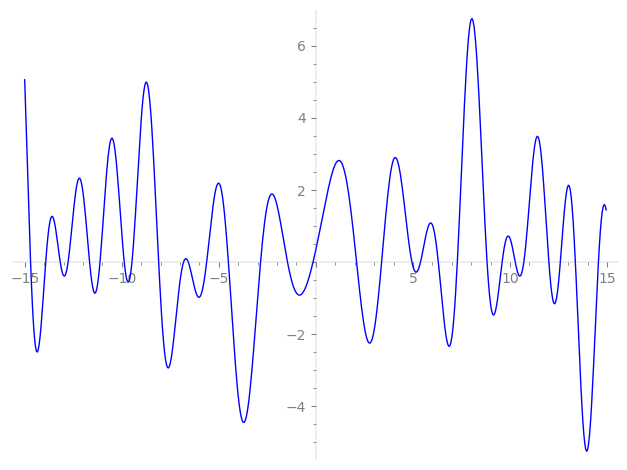| L(s) = 1 | + (−2.71 − 2.71i)3-s + (4.98 − 0.435i)5-s + (−5.23 − 4.64i)7-s + 5.72i·9-s − 8.05i·11-s + (−12.1 + 12.1i)13-s + (−14.6 − 12.3i)15-s + (−4.68 − 4.68i)17-s − 3.49i·19-s + (1.62 + 26.8i)21-s + (4.14 − 4.14i)23-s + (24.6 − 4.33i)25-s + (−8.87 + 8.87i)27-s − 42.7i·29-s − 7.32·31-s + ⋯ |
| L(s) = 1 | + (−0.904 − 0.904i)3-s + (0.996 − 0.0870i)5-s + (−0.748 − 0.663i)7-s + 0.636i·9-s − 0.732i·11-s + (−0.932 + 0.932i)13-s + (−0.979 − 0.822i)15-s + (−0.275 − 0.275i)17-s − 0.183i·19-s + (0.0772 + 1.27i)21-s + (0.180 − 0.180i)23-s + (0.984 − 0.173i)25-s + (−0.328 + 0.328i)27-s − 1.47i·29-s − 0.236·31-s + ⋯ |
\[\begin{aligned}\Lambda(s)=\mathstrut & 560 ^{s/2} \, \Gamma_{\C}(s) \, L(s)\cr =\mathstrut & (-0.785 - 0.619i)\, \overline{\Lambda}(3-s) \end{aligned}\]
\[\begin{aligned}\Lambda(s)=\mathstrut & 560 ^{s/2} \, \Gamma_{\C}(s+1) \, L(s)\cr =\mathstrut & (-0.785 - 0.619i)\, \overline{\Lambda}(1-s) \end{aligned}\]
Particular Values
| \(L(\frac{3}{2})\) |
\(\approx\) |
\(0.3542379492\) |
| \(L(\frac12)\) |
\(\approx\) |
\(0.3542379492\) |
| \(L(2)\) |
|
not available |
| \(L(1)\) |
|
not available |
\(L(s) = \displaystyle \prod_{p} F_p(p^{-s})^{-1} \)
| $p$ | $F_p(T)$ |
|---|
| bad | 2 | \( 1 \) |
| 5 | \( 1 + (-4.98 + 0.435i)T \) |
| 7 | \( 1 + (5.23 + 4.64i)T \) |
| good | 3 | \( 1 + (2.71 + 2.71i)T + 9iT^{2} \) |
| 11 | \( 1 + 8.05iT - 121T^{2} \) |
| 13 | \( 1 + (12.1 - 12.1i)T - 169iT^{2} \) |
| 17 | \( 1 + (4.68 + 4.68i)T + 289iT^{2} \) |
| 19 | \( 1 + 3.49iT - 361T^{2} \) |
| 23 | \( 1 + (-4.14 + 4.14i)T - 529iT^{2} \) |
| 29 | \( 1 + 42.7iT - 841T^{2} \) |
| 31 | \( 1 + 7.32T + 961T^{2} \) |
| 37 | \( 1 + (10.4 - 10.4i)T - 1.36e3iT^{2} \) |
| 41 | \( 1 - 51.4iT - 1.68e3T^{2} \) |
| 43 | \( 1 + (37.8 - 37.8i)T - 1.84e3iT^{2} \) |
| 47 | \( 1 + (49.4 - 49.4i)T - 2.20e3iT^{2} \) |
| 53 | \( 1 + (49.7 + 49.7i)T + 2.80e3iT^{2} \) |
| 59 | \( 1 + 74.7iT - 3.48e3T^{2} \) |
| 61 | \( 1 - 43.1iT - 3.72e3T^{2} \) |
| 67 | \( 1 + (-57.2 - 57.2i)T + 4.48e3iT^{2} \) |
| 71 | \( 1 - 45.6iT - 5.04e3T^{2} \) |
| 73 | \( 1 + (53.0 - 53.0i)T - 5.32e3iT^{2} \) |
| 79 | \( 1 + 96.4T + 6.24e3T^{2} \) |
| 83 | \( 1 + (-52.7 - 52.7i)T + 6.88e3iT^{2} \) |
| 89 | \( 1 + 31.9T + 7.92e3T^{2} \) |
| 97 | \( 1 + (-19.5 - 19.5i)T + 9.40e3iT^{2} \) |
| show more | |
| show less | |
\(L(s) = \displaystyle\prod_p \ \prod_{j=1}^{2} (1 - \alpha_{j,p}\, p^{-s})^{-1}\)
Imaginary part of the first few zeros on the critical line
−9.871162736657209586312127924406, −9.474317256771257073151014724539, −8.099580489766779854136588429534, −6.81856606323009211419204791198, −6.57142346201448697166038760121, −5.62759624443936167095145766909, −4.50740038939855982958664034660, −2.85107338855410220266737239125, −1.46216152780614403609989330124, −0.14832413244067645909300506975,
2.09472926743621654475327803843, 3.38475406433846253881459547445, 4.94734693008817981020876320966, 5.38701178294926301002675372817, 6.30552079515838779427183442744, 7.28413364792415741572230629647, 8.816163957100524559455019216012, 9.591524793802223010421117715928, 10.26907611940434932709993312203, 10.70960744678088218450388082271

